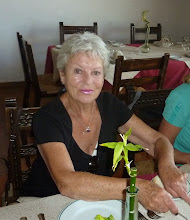Hattie, who commented on the previous post and mentioned the Fohn, got me thinking about the different winds. When I lived in Arabia we had one, the Khamsin, which if you were out in the desert, would sandblast the paint of your car. So here, thanks to Wikipaedia, is some information on other winds.
Gone with the Loo
There are dozens of names for winds that blow through specific regions. Some,
like the noreasters that blow from the northeast down the East Coast, are not
creatively named. Here are some others:
barber: cold, moisture-laden wind that freezes on contact with hair and beards.
brickfielder: hot, dry
wind that carries enormous amounts of red dust from the deserts of southern
Australia.
Cape Doctor: cold, dry
wind from the southeast that sanitizes the city of Cape Town, South Africa.
chinook: warming wind
rushing eastward down the Rocky Mountains of Canada and the U.S.
Coromuel: strong, warm
wind that blows from afternoon to early morning through La Paz, Baja
California, Mexico. The wind was named after British sailor Samuel Cromwell,
whose name the locals could not pronounce.
Hawk: strong, cool
breeze blowing westward through Chicago from Lake Michigan.
levant: strong winds
that blow from the Atlantic Ocean through the narrow Strait of Gibraltar in the
western Mediterranean Sea. The Levant, the Mideast region in the eastern
Mediterranean, does not experience the levant.
Loo: strong, hot
summer wind that blows across northern India from the arid deserts to the west,
and is only stopped by the arrival of the monsoon. The Loo is such a powerful
ecological and cultural force that ice creams and sherbets are consumed to
combat Loo-induced fatigue.
November witch:
hurricane-force winds that develop as cold Arctic air masses meet warm air from
the Gulf over the Great Lakes.
Pembrokeshire Dangler:
area where prevailing winds converge and cause a line of cold rain and snow to
dangle north-south across the Irish Sea.
Santa Anas: hot, dry
winds that blow from the deserts and mountains of inland California to the
coast. Santa Anas are often responsible for spreading Southern Californias
destructive wildfires, earning them the nickname murder winds.
sirocco: wind that
reaches hurricane speeds as it crosses the Mediterranean Sea to southern
Europe. Siroccos carry tons of dust and sand throughout northern Africa, and
contribute to wet weather as they reach Europe.
squamish: fast-moving,
cold wind that rushes down the narrow fjords of British Columbia, Canada.
And the others I came across
the Haboob, a violent wind which raises sand storms, especially in N. Africa.
the Mistral, a violent dry, cold N.W. wind along the Spanish and French coast.
Do you have a strong, specially named, wind in your area?

1 comment:
I had no idea about most of these.
What we get are the gentle trades, which bring us clean air from over thousands of miles of ocean. When the trades die down, which they do on occasion, we get volcanic smog, or vog, from the actively erupting Kilauea and Pu'u'oo eruptions about 25 miles away from us.
So many winds. Last night a friend was talking about ocean currents, the water "winds" that drive our weather. Such a fascinating planet we live on!
Post a Comment